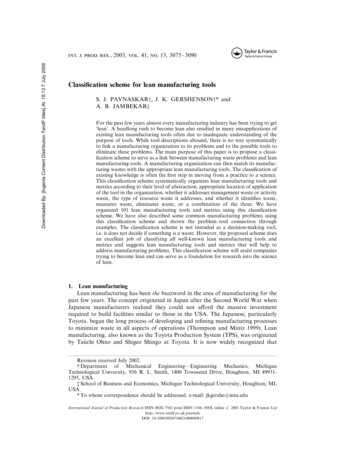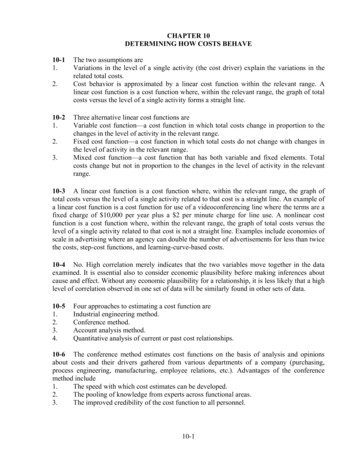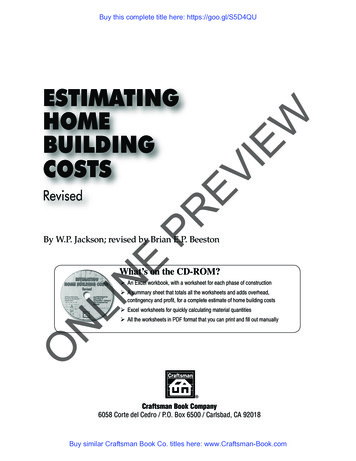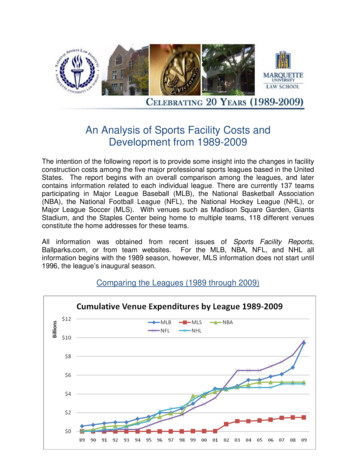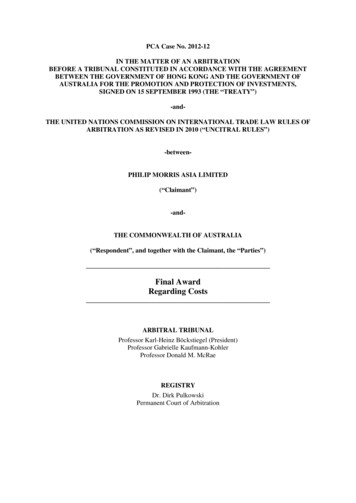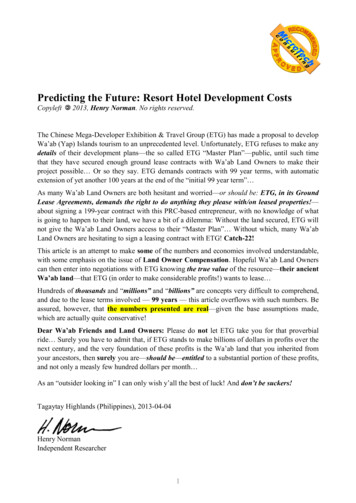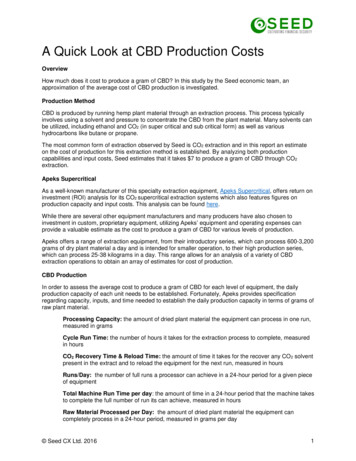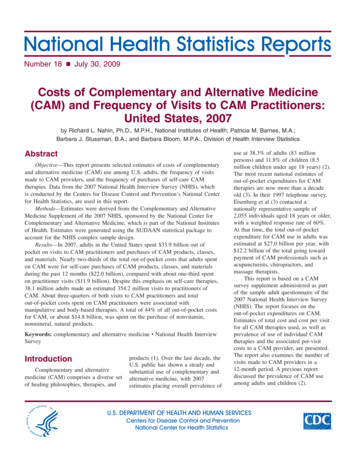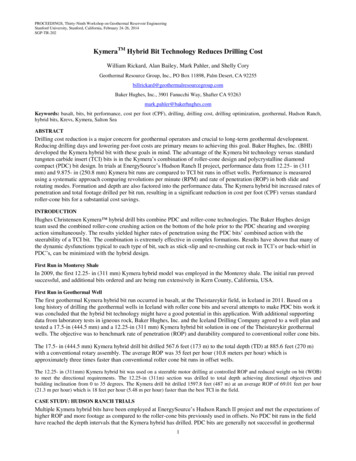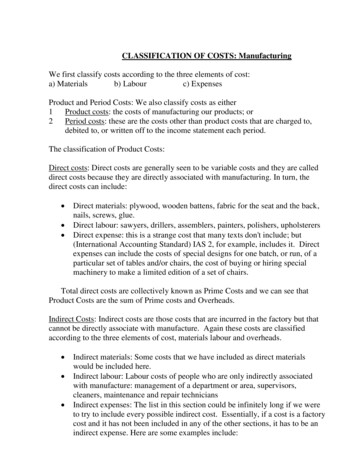
Transcription
CLASSIFICATION OF COSTS: ManufacturingWe first classify costs according to the three elements of cost:a) Materialsb) Labourc) ExpensesProduct and Period Costs: We also classify costs as either1Product costs: the costs of manufacturing our products; or2Period costs: these are the costs other than product costs that are charged to,debited to, or written off to the income statement each period.The classification of Product Costs:Direct costs: Direct costs are generally seen to be variable costs and they are calleddirect costs because they are directly associated with manufacturing. In turn, thedirect costs can include: Direct materials: plywood, wooden battens, fabric for the seat and the back,nails, screws, glue.Direct labour: sawyers, drillers, assemblers, painters, polishers, upholsterersDirect expense: this is a strange cost that many texts don't include; but(International Accounting Standard) IAS 2, for example, includes it. Directexpenses can include the costs of special designs for one batch, or run, of aparticular set of tables and/or chairs, the cost of buying or hiring specialmachinery to make a limited edition of a set of chairs.Total direct costs are collectively known as Prime Costs and we can see thatProduct Costs are the sum of Prime costs and Overheads.Indirect Costs: Indirect costs are those costs that are incurred in the factory but thatcannot be directly associate with manufacture. Again these costs are classifiedaccording to the three elements of cost, materials labour and overheads. Indirect materials: Some costs that we have included as direct materialswould be included here.Indirect labour: Labour costs of people who are only indirectly associatedwith manufacture: management of a department or area, supervisors,cleaners, maintenance and repair techniciansIndirect expenses: The list in this section could be infinitely long if we wereto try to include every possible indirect cost. Essentially, if a cost is a factorycost and it has not been included in any of the other sections, it has to be anindirect expense. Here are some examples include:
Depreciation of equipment, machinery, vehicles, buildingsElectricity, water, telephone, rent, Council Tax, insuranceTotal indirect costs are collectively known as Overheads.Finally, within Product Costs, we have Conversion Costs: these are the costsincurred in the factory that are incurred in the conversion of materials into finishedgoods.The classification of Period Costs:The scheme shows five sub classifications for Period Costs. When we lookat different organisations, we find that they have period costs that might have subclassifications with entirely different names. Unfortunately, this is the nature of theclassification of period costs; it can vary so much according to the organisation, theindustry and so on. Nevertheless, such a scheme is useful in that it gives us the basicideas to work on.Administration Costs: Literally the costs of running the administrative aspects of anorganization. Administration costs will include salaries, rent, Council Tax,electricity, water, telephone, depreciation, a potentially infinitely long list. Noticethat there are costs here such as rent, Council Tax, that appear in several subclassifications; in such cases, it should be clear that we are paying rent on buildings,for example, that we use for manufacturing and storage and administration and eacharea of the business must pay for its share of the total cost under review.Without wishing to overly extend this listing now, we can conclude thisdiscussion by saying that the costs of Selling, the costs of Distribution and the costsof Research are all accumulated in a similar way to the way in which AdministrationCosts are accumulated. Consequently, our task is to look at the selling process andclassify the costs of running that process accordingly: advertising, market research,salaries, bonuses, electricity, and so on. The same applies to all other classificationsof period costs that we might use.Finance Costs: Finance costs are those costs associated with providing thepermanent, long term and short term finance. That is, within the section headedfinance costs we will find dividends, interest on long term loans and interest on shortterm loans.Finally, we should say that we can add any number of sub classifications toour scheme if we need to do that to clarify the ways in which our organisationoperates. We will also add further sub classifications if we need to refine and furtherrefine out cost analysis.
COST SHEET – FORMATParticularsOpening Stock of Raw MaterialAdd: Purchase of Raw materialsAdd: Purchase ExpensesLess: Closing stock of Raw MaterialsRaw Materials ConsumedDirect Wages (Labour)Direct ChargesPrime cost (1)Add :- Factory Over Heads:Factory RentFactory PowerIndirect MaterialIndirect WagesSupervisor SalaryDrawing Office SalaryFactory InsuranceFactory Asset DepreciationWorks cost IncurredAdd: Opening Stock of WIPLess: Closing Stock of WIPWorks cost (2)Add:- Administration Over Heads:Office RentAsset DepreciationGeneral ChargesAudit FeesBank ChargesCounting house SalaryOther Office ExpensesCost of Production (3)Add: Opening stock of Finished GoodsLess: Closing stock of Finished GoodsCost of Goods SoldAdd:- Selling and Distribution OH:Sales man CommissionAmount **
Sales man salaryTraveling ExpensesAdvertisementDelivery man expensesSales TaxBad DebtsCost of Sales (5)Profit (balancing figure)Sales***************************Notes:1) Factory Over Heads are recovered as a percentage of direct wages2) Administration Over Heads, Selling and Distribution Overheads are recovered asa percentage of works cost.MATERIAL1) Reorder level Maximum usage * Maximum lead time(Or) Minimum level (Average usage * Average Lead time)
2) Minimum level Reorder level – (Average usage * Average lead time)3) Maximum level Reorder level Reorder quantity – (Minimum usage *Minimum lead time)4) Average level Minimum level Maximum level2Minimum level ½ Reorder quantity(or)5) Danger level (or) safety stock level Minimum usage * Minimum lead time (preferred)(or)Average usage * Average lead time(or)Average usage * Lead time for emergency purposes6) EOQ (Economic Order Quantity - Wilson’s Formula) 2AO/CWhere A Annual usage unitsO Ordering cost per unitC Annual carrying cost of one uniti.e. Carrying cast % * Carrying cost of unit7) Associated cost Buying cost pa Carrying cost pa8) Under EOQ Buying cost Carrying cost9) Carrying Cost Average inventory * Carrying cost per unit pa * Carrying cost %(Or)Average Inventory * Carrying cost per order pa10) Average inventory EOQ/211) Buying cost Number of Orders * ordering cost12) Number of Orders Annual Demand / EOQ13) Inventory Turnover (T.O) Ratio Material consumedAverage Inventory14) Inventory T.O Period 365.Inventory Turn over Ratio15) safety stock Annual Demand *(Maximum lead time - Average lead time)36516) Total Inventory cost Ordering cost Carrying cost of inventory Purchase cost17) Input Output Ratio Quantity of input of material to production
Standard material content of actual outputRemarks :1) High Inventory T.O Ratio indicates that the material in the question is fast moving2) Low Inventory T.O Ratio indicates over investment and locking up of workingCapital in inventoriesPricing of material Issues:1) Cost price method:a) Specific price methodb) First in First Out method (FIFO)c) Last in First Out method (LIFO)d) Base stock method2) Average price method:a) Simple average price method Total unit priceTotal No. of purchasesb) Weighted average price method Total costTotal No. of unitsc) Periodic simple average price method Total unit price of certain periodTotal Number of purchases of that period(This rate is used for all issues for that period. Period means a month (or) week (or)year)d) Periodic weighted average price method Total cost of certain periodTotal Number of units of that periode) Moving simple average price method Total of periodic simple average of certain number of periodsNumber of periodsf) Moving weighted average price method Total of periodic weighted average of certain number of periodsNumber of periods
3) Market price method:a) Replacement price method Issues are valued as if it was purchased now atcurrent market priceb) Realizable price method Issues are valued at price if it is sold now4) Notional price method:a) Standard price method Materials are priced at pre determined rate (or)Standard rateb) Inflated price method The issue price is inflated to cover the losses incurreddue to natural(or)climatic losses5) Re use price method When materials are returned (or) rejected it is valued atdifferent price. There is no final procedure for this method.ABC Analysis (or) Pareto Analysis :- In this materials are categorized intoParticulars“A” – Important material“B” – Neither important nor unimportant“C” – UN ImportantQuantity10%20%70%Value70%20%10%Note:1) Material received as replacement from supplier is treated as fresh supply2) If any material is returned from Department after issue, it has to be firstdisposed in the next issue of material3) loss in the book balance of stock and actual is to be transferred to Inventoryadjustment a/c and from there if the loss is normal it is transferred to Over Headcontrol a/c. If it is abnormal it is transferred to costing profit and loss a/c.4) CIF Cost Insurance and Freight (This consignment is inclusive of prepaidinsurance and freight)5) FOB Free on Board (Materials moving by sea – insurance premium is notpaid)
6) FOR Free on Rail (Insurance and freight is not borne by the supplier but paidby the company or purchase)7) For each receipt of goods Goods Receipt note8) For each issue of goods Materials Requisition note (or) Material Issue noteAccounting Treatment :1) Normal Wastage It should be distributed over goods output increasing per unitcost2) Abnormal Wastage It will be charged to costing profit and loss a/c3) Sale value of scrap is credited to costing profit and loss a/c as an abnormal gain.4) Sale proceeds of the scrap can be deducted from material cost or factoryoverheads.5) Sale proceeds of scrap may be credited to particular job.6) Normal Defectives cost of rectification of defectives should be charged tospecific7) Abnormal Defectives This should be charged to costing profit and loss a/c8) Cost of Normal spoilage is to borne by good units9) Abnormal spoilage should be charged to costing profit and loss a/cLABOURMethod of Remuneration:
1) Time Rate systema) Flat time Rateb) High wage systemc) Graduated time rate2) Payment by Resultsa) Piece rate systemi) Straight piece rateii) Differential piece rate Taylor system Merrick systemb) Group Bonus Systemi) Budgeted Expensesii) Towne gain sharing schemeiii) Cost efficiency bonusiv) Priest man systemc) Combination of Time and Piece ratei) Gantt task and Bonus schemeii) Emerson Efficiency systemiii) Point scheme Bedaux system Haynes manit systemd) Premium bonus plansi) Halsey premium planii) Halsey weir premium planiii) Rowan schemeiv) Barth schemev) Accelerating premium bonus schemee) Other incentive schemesi) Indirect monetary incentive Profit sharing Co-partnershipii) Non-Monetary Incentive1) Time rate system Hours worked * Rate per hour (Basic wages)
2) Piece rate system:i) Straight piece rate earnings Number of units produced * Rate per unitii) Differential Piece ratea) F.W.Taylor’s differential rate system» 83% of piece rate when below standard» 125% of piece rate when above or at standardb) Merrick differential or multiple piece rate systemEfficiency level» up to 83%» 83% to 100%» Above 100%Piece rate»Normal piece rate» 110% of Normal rate» 120% of Normal rateiii) Gantt Task and Bonus systemOutput» Below standard» At standard» Above standardPayment» Time rate (guaranteed)» 20% Bonus of Time rate» 120% of ordinary piece rateiv) Emerson’s Efficiency systemEfficiency» Below 66.7%» from 66.7%to 100%» Above 100%Payment» Hourly Rate» Hourly rate ( ) increasing bonus according to degreeof efficiency on the basis of step bonus rates» Hourly rate ( ) 20% Bonus ( ) additional bonus of 1%of hourly rate for every 1% increase in efficiencyv) Halsey Premium Plan Basic wages 50% of time saved * Hourly Ratevi) Halsey Weir Premium Plan Basic wages 30% of time saved * Hourly ratevii) Rowan Plan Basic wages Time savedTime allowed* Basic Wagesviii) Bedaus Point system Basic wages 75% * Bedaus point/60 * Rate/hrix) Barth’s System Hourly rate * Std time *Time taken
Labour Turnover:1) Separation rate method Separation during the periodAverage No. of worker’s during the period2) Net labour T.O rate (or) Replacement method Number of replacementsAverage No. of worker’s during the period3) Labour flux rate No. of separation No. of replacementAverage No. of worker’s during the periodAccounting Treatment1) Normal Idle time Charged to factory overheads2) Normal but un-controllable It should be charged to job by inflating wage rate.3) Abnormal It should be charged to costing P & L a/cOVER HEADS
Reapportionment of service department expenses over production department :1) Direct redistribution method: Service department costs are divided over production department. Ignore service rended by one dept. to another2) Step method of secondary distribution (or) Non reciprocal method: Service department which serves largest number of service department isdivided first and go on.3) Reciprocal service method:i) Simultaneous equation method (or) Algebraic method Equation is formed between service departments and is solved to find theamount due.ii) Repeated distribution method: Service department cost separated repeatedly till figure of service dept. isexhausted or too small.iii) Trial and Error method: Cost of service departmen
4) Notional price method:- a) Standard price method Materials are priced at pre determined rate (or) Standard rate b) Inflated price method The issue price is inflated to cover the losses incurred due to natural(or)climatic losses 5) Re use price method When materials are returned (or) rejected it is valued at different price. There is no final procedure for this method.

